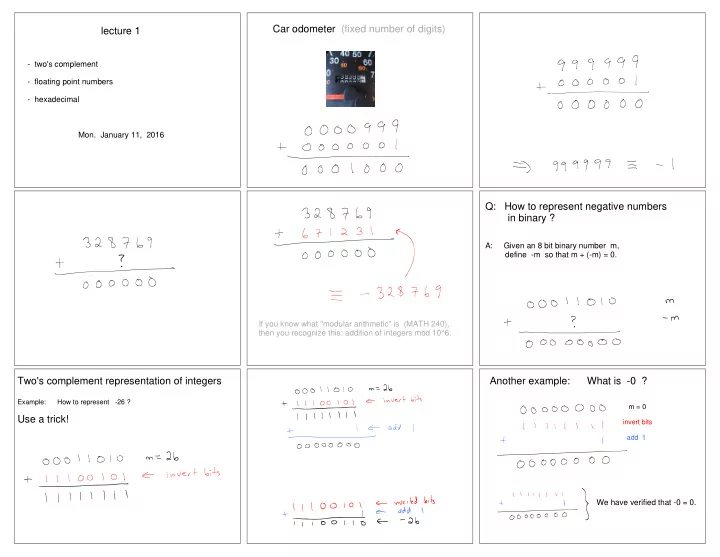

Car odometer (fixed number of digits) lecture 1 - two's complement - floating point numbers - hexadecimal Mon. January 11, 2016 Q: How to represent negative numbers in binary ? A: Given an 8 bit binary number m, define -m so that m + (-m) = 0. If you know what "modular arithmetic" is (MATH 240), then you recognize this: addition of integers mod 10^6. Two's complement representation of integers Another example: What is -0 ? Example: How to represent -26 ? m = 0 Use a trick! invert bits add 1 We have verified that -0 = 0.
What about m = 128 ? What is -128 ? binary "unsigned" "signed" signed integers m = 128 invert bits add 1 positive most significant bit negative m = - 128 Thus, 128 is equivalent to -128. 8 bit integers (unsigned vs. signed) n bits defines 2^n integers Take n = 32. The largest signed integer is 2^31 - 1. unsigned 2 ^ 10 = 1024 ~ 10 ^ 3 = one thousand. 2 ^ 20 ~ 10 ^ 6 = one million signed 2 ^ 30 ~ 10 ^ 9 = one billion 2 ^ 31 ~ 2,000,000,000 = two billion Floating Point lecture 1 Java Example "decimal point" - two's complement This gives a compiler error. "The literal of type int is out of range." - floating point numbers - hexadecimal "binary point" // This prints out -294967296. Mon. January 11, 2016 // To understand why these particular digits are printed, you // would need to convert 4000000000 to binary, which I don't // recommend.)
How to convert from decimal to binary ? Convert from binary to decimal What about negative powers of 2 ? We must use both positive and negative powers of 2. In general, note that multiplying by 2 shifts bits to the left (or shifts binary point to the right) To find the bits for the positive powers of 2, use the algorithm from last lecture ("repeated division") . Example: Sum up the contributing 1 bits as on previous slide. Similarly....dividing by 2 and not ignoring remainder shifts For the negative powers of 2, use "repeated multiplication" A more subtle example: bits to the right (or shifts binary point to the left) First, find the bits for the positive powers of 2 using "repeated division" (last lecture). convert decimal to binary Then find the bits for the negative powers of 2 using Then find the bits for the negative powers of 2 using repeated multiplication. repeated multiplication. We cannot get an exact representation using a finite number of bits for this example. Can we say anything more general about what happens ? Note the summation is over bits bi from -5, -6, ..., - infinity.
Recall previous example... When we convert a floating point decimal number with a finite number of digits into binary, we get: This will - a finite number of non-zero bits to left of binary point repeat over and over - an infinitely repeating sequence of bits to the right of the again. binary point Why ? [Note: sometimes the infinite number of repeating bits are all 0's, as in the case of 0.375 a few slides back.] Eventually, the three digits to the right of the decimal point will enter a cycle that repeats forever. This will produce a bit string that repeats forever. Examples of hexadecimal Hexadecimal See Exercises 1 Questions 1-7. 1) 0010 1111 1010 0011 2 f a 3 Quiz 1 will be on Monday Jan 18. Writing down long (15 minutes at start of class) We write 0x2fa3 or 0X2FA3. strings of bits is awkward and error prone. Hexadecimal simplifies Waiting list issues. (I will speak with admin.) 2) 101100 the representation. OSD issues. They don't handle 15 min We write 0x2c (10 1100), not 0xb0 (1011 00) quizzes.
Recommend
More recommend